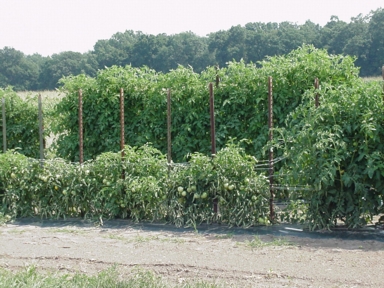Tomato Support Systems
Tomatoes for the fresh market can be grown with or without support for the plant. Support typically reduces the number of culls and makes it easier to harvest. Usually, the taller the variety, the greater the need for support to make harvest easier. The most common system for the 'semi-determinate' varieties commonly grown commercially in the Midwest (i.e. Mountain Spring) is known as the Florida Weave.
Florida Weave

- Stakes are driven into the ground in the row between tomato plants. Depending on the strength of the stake and size of plants, stakes may be placed between each plant or between every other plant. The stakes may be wooden posts, rebar, metal fence posts, etc. They should be about as tall as the tomato plant's final height, or taller. At the end of rows, the last stake may need extra support to prevent leaning under tension once string is attached. In this experimental plot a combination of 1"X1"X4' Honduran pine (available from vegetable equipment suppliers) and metal fence posts are used. Stakes are placed between each plant because experience showed the wooden stakes were not strong enough to hold two plants.
- Before plants begin to lean over, when they are about a foot tall, a row of string is strung along either side of the plants. First, the string is tied off at the end of the row 6 to 8 inches from the ground. Next, the string is taken past the plant (or plants), pulled fairly tight, and wrapped around the next stake at the same height above the ground. This is repeated to the end of the row. The string is wrapped around (or tied) at the end stake and brought back on the other side of the row at the same height, wrapped around each stake, and tied off again at the end of the row. When a row is completed, the main stems of the tomato plants should be supported between the two lines of string, one line on each side of the row. The string is not wrapped around any part of the plants. See photos of the tying process here. When plants have another 6 to 8 inches of growth, and before they lean over, another string is installed 6 to 8 inches above the first. In this photo, two runs of string have been applied. The plant on the right was pruned and the plant on the right was not. (See below for more on pruning.)
- The stringing process continues until the plants reach their final height. Care should be taken to avoid damaging flower clusters during stringing.
- Tomato twine is sold in boxes that can be attached to a belt. A length of 1/2-inch pvc pipe about 2 ft. long can be used to aid in stringing. The string is threaded through the pipe and the pipe is held in one hand and used to guide the string around the posts at the correct height while maintaining tension on the string.
- Plants supported in this manner are sometimes pruned to remove some of the branches below the first flower cluster. Pruning will result in increased fruit size and lower overall yield, with the magnitude of the changes depending on variety. A severe pruning would leave 0 or 1 branch just below the first flower cluster. A moderate pruning would leave 3 branches below the first flower cluster.
